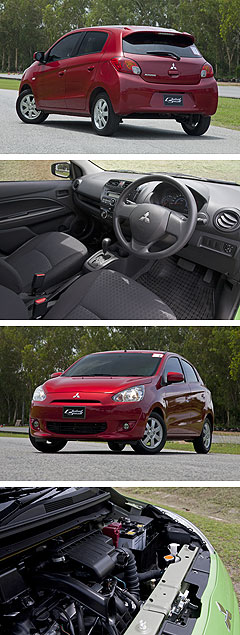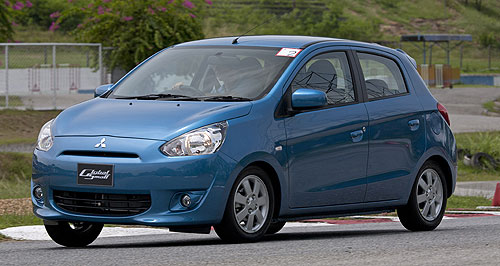Make / Model Search
Future models - Mitsubishi - MirageFirst drive: Frugal Mirage aims for valueReturn of the Mirage: Mitsubishi’s long-awaited Colt replacement will arrive in Australia early next year and is expected to significantly boost the brand’s sales. Mitsubishi targets $13K entry price and generous spec for Thai-built Mirage24 May 2012 By HAITHAM RAZAGUI in BANGKOK MITSUBISHI’S all-new Thai-built Mirage light car will be priced from around $13,000 when it hits Australian showrooms in January 2013 – putting the similar-sized Nissan Micra in its crosshairs – and the company expects to sell between 600 and 650 units per month. Mitsubishi Australia vice-president of sales Anthony Casey said the replacement for the slow-selling Colt – which for more than a year has struggled to break triple-digit monthly sales, averaging around 200 units per month and rarely achieving more than 300 since launch – will provide an extra half-per cent market share boost for the Japanese brand. There will be two variants for Australia, neither of which will get the 1.0-litre version of the super-frugal three-cylinder petrol engine that will be available in other markets. Instead, Australian Mirages will be powered by a 57kW/100Nm 1.2-litre three-cylinder petrol that is expected to return similar fuel consumption to the Thai-market car’s 4.2 litres per 100 kilometres, with CO2 emissions of 107 grams per kilometre. Compared with the 1.2-litre Micra (5.9L/100km), Holden Barina Spark (5.6L/100km) and Suzuki Alto (4.8L/100km), the Mirage’s fuel consumption is still low enough to make it a leader in its price range. Mitsubishi Australia vice-president for customer and brand management Paul Unerkov said the company will specify the manual entry-level variant as highly as it can for $13,000, with a priority on safety equipment. “It’ll have the safety, it’ll have the fuel economy – which will be class-leading – it will be price-competitive, so fairly highly specified at a pretty good value-for-money position, and it’ll come in a range of seven or eight colours.”  He confirmed the Mirage will come with six airbags, electronic stability control, anti-lock brakes with electronic brake-force distribution, three-point seatbelts all round and rear head restraints. He confirmed the Mirage will come with six airbags, electronic stability control, anti-lock brakes with electronic brake-force distribution, three-point seatbelts all round and rear head restraints.Mitsubishi expects the car to achieve a five-star ANCAP crash-safety rating. Australian-market Mirages will also come with hill start assist on models fitted with the automatic continuously-variable transmission (CVT), a roof spoiler that enhances the aerodynamics and looks of the car, and a stabiliser bar on the front suspension. Mitsubishi is hoping to benefit from the good name and popularity of the old Mirage hatch, which was discontinued in 2004 when the more expensive Colt arrived. In line with the rest of the segment, it is aiming the car at people aged under 35 years old and those over 60. Although around 210mm longer than the Indian-built Suzuki Alto, the 830-865kg Mirage is around 50kg lighter and its nondescript, minimalist styling – a world away from the angular, wagon-like Colt it replaces – enables it to slice through the air with a slippery 0.29 coefficient of drag. The Mirage will be available with a five-speed manual gearbox or CVT automatic. The CVT adds 35kg of weight and was selected over a less-expensive traditional torque-converter unit for its ability to improve fuel consumption. To drive the Mirage, GoAuto travelled to the Bira International Circuit 140km south-east of Bangkok, a race track frequently used for testing by brands that build vehicles in Thailand. We drove Thai-spec Mirages fitted with the 1.2-litre engine destined for Australia, but all lacked the Aussie-spec front stabiliser bar, leading to less composure through corners and perhaps contributing to the squirming we experienced under hard braking. With almost identical power and torque outputs to the similar three-cylinder 1.2-litre Nissan Micra but haul around at least 100kg less weight, we expected keen performance from the Mirage. This expectation was shattered as we pulled away in the CVT, even with Sport mode selected, and the transmission seemed to suck the life out of the engine as we executed a full-throttle take-off. Only when approaching 100km/h did the CVT appear to let the engine really come on song, with a tangible step-change in the rate of acceleration. While this might come in handy for motorway on-ramps or added confidence for country road overtaking, a city-oriented car like the Mirage should exhibit far more pep at lower speeds for nipping in and out of traffic and have a more positive reaction for making a quick getaway at the lights. Even the CVT-equipped Suzuki Swift Sport suffers a similar problem. That said, during gentler driving, the CVT provided smooth progress, albeit with the droning under acceleration typical of this type of transmission. We preferred the easy-to-use, slick-shifting five-speed manual with its light clutch pedal, which enabled far more to be wrung from the little engine, making the Mirage feel far quicker. More than willing to be revved beyond its 6000rpm power peak, the three-cylinder has wide vocal range from deep motorcycle-like burble at idle and low speeds through to an entertaining three-pot thrum at high revs. Mitsubishi says Australian-delivered cars will receive more sound-deadening, but on the smooth surface of the circuit the manual Mirage was quiet, refined and the manual was happy to trickle along at 60km/h in fifth gear. We were not enamoured with the Mirage’s over-assisted, uncommunicative steering, which requires large inputs, and because of this, in the context of our circuit environment it was hard to imagine the car being nimble in traffic, a shame given the potential dynamic advantages of its lightweight construction. The softly sprung suspension setup is sure to provide a cosseting ride and we will reserve judgement on the roly-poly cornering and lack of sharp turn-in until we have tried a Mirage with the Aussie-spec stabiliser bars. The cars we drove were not fitted with ESC, but road-holding was predictable and controllable when the skinny low-rolling-resistance tyres were pushed to their squealing limit on fast bends, and a pair of chicanes showcased the advantage of a lightweight design when dispatching rapid direction changes. We expected such a light car to feel more agile, though, and the Mirage is no Suzuki Swift in dynamic terms. But this is something we can live with in a car so clearly optimised for efficiency. Even with drums at the back, the lack of weight to bring under control meant the brakes provided decent stopping power, with a pleasant and progressive pedal feel to boot. Australian interior trim styles are yet to be finalised, but the Mirages we drove were overwhelmingly black inside, with no let-up from hard plastic, even on the door trims. Plasticky interiors are to be expected at this price point but the quality of the materials, as well as fit and finish, were up to scratch on the Mirages we poked around in. The design was inoffensive and we were pleased by the well-chosen textures. Up front there are door bins with bottle-holders, a large glove compartment (with shallow tray above), cup-holders and storage trays, while rear passengers get a single drink-holder, one map pocket and a hook attached to the front passenger head restraint. The front seats are somewhat flat but otherwise comfortably supportive, and we easily found an ideal driving position despite the lack of steering wheel reach adjustment. We found the instruments easy to read and were pleased to find a tripmeter with fuel consumption and tank range readouts, with all controls intuitively located and easy to reach. Entry-level models featured an integrated in-dash audio system and manual ventilation controls plus air-conditioning powerful enough to cope with Thailand’s heat and humidity while not sapping any discernible power from the engine. Up-spec models get a touchscreen navigation system as seen on other Mitsubishi models, featuring DVD player and Bluetooth connectivity plus an upgrade to automatic air-conditioning (with LCD readout that we found hard to see while wearing polarised sunglasses) and keyless entry with engine starter button. All seating positions provided plenty of headroom and, even with the front seat adjusted for your 186cm-tall correspondent, there was just enough knee-room in the back, with a bench just about wide enough to accommodate three average-sized adults for a short trip. No boot space figures were provided, but with the seats up and parcel shelf in place we estimate enough room for a couple of cabin baggage-sized suitcases, which expands considerably with the 60/40 split rear bench folded forwards, but there is a high lip to lift items over before placing them inside. If Mitsubishi Australia can put together the strong value proposition they are aiming for with the Mirage, it should be a strong contender in this price-sensitive segment, where simple A-B transport is required with the lowest possible running costs. In addition to the Mirage’s fuel efficiency and price, the inclusion of Mitsubishi’s five-year Diamond Advantage warranty and capped-price servicing offer might just seal the deal for many buyers.  Read more17th of May 2012  Mitsubishi boosts Mirage productionMirage light car production upped in Thailand as Mitsubishi responds to high demandAll future modelsMirage pricingMotor industry news |
Click to shareMitsubishi modelsResearch Mitsubishi All future modelsMirage pricingMotor industry news |



 Alfa Romeo
Alfa Romeo Abarth
Abarth Audi
Audi Aston Martin
Aston Martin BMW
BMW Bentley
Bentley Ferrari
Ferrari Chevrolet
Chevrolet Ford
Ford Fiat
Fiat GWM
GWM Foton
Foton Hyundai
Hyundai Honda
Honda Jaguar
Jaguar Isuzu
Isuzu Kia
Kia Jeep
Jeep Land Rover
Land Rover Lamborghini
Lamborghini Maserati
Maserati Lexus
Lexus McLaren
McLaren Mazda
Mazda Mercedes-Benz
Mercedes-Benz Mitsubishi
Mitsubishi Mini
Mini Peugeot
Peugeot Nissan
Nissan Ram
Ram Porsche
Porsche Rolls-Royce
Rolls-Royce Smart
Smart Skoda
Skoda Suzuki
Suzuki Subaru
Subaru Toyota
Toyota Tesla
Tesla Volvo
Volvo Zeekr
Zeekr







Facebook Twitter Instagram